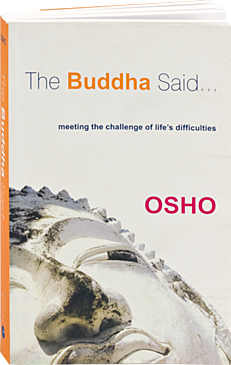The Buddha Said

The Buddha Said
Meeting the Challenge of Life's Difficulties
Book
This comprehensive volume contains all the "sutra chapters" from the original 4-volume series of talks given by Osho under the title, "The Discipline of Transcendence." It is Buddha presented by Osho in his most practical, down-to-earth, and compassionate aspects, a guide to living fully and wisely and well in the 21st Century. UK/Commonwealth and North American editions are available.
Chapter Titles
# 1: The Most Excellent Way
# 2: No Prejudice in the Heart
# 3: Be Therefore Mindful
# 4: Living the Dhamma
# 5: The Truth Beyond Magic
# 6: The Twenty Difficult Things
# 7: In Accord with the Way
# 8: Alight Unto Yourself
# 9: Reflections of Emptiness
# 10: The Discipline Beyond Discipline
#Chapetr 11: Spirutual Enlightenment
# 12: Always on the Funeral Pyre
# 13: There Is Nothing like Lust
# 14: Become a Driftwood
# 15: Just Working for Peanuts
# 16: Away With the Passions!
# 17: The Eightfold Way
# 18: Remember the Middle
# 19: The Discipline of Transcendence
# 20: The Ten Grounds of the Way
# 21: Provisions for the Journey
# 22: Collecting Pebbles on the Seashore of Life
Details
Osho explains the relevance of Buddha’s "Sutra of 42 Chapters" for our times - line by line, in fresh and contemporary language.
Excerpt from: The Buddha Said
"This sutra, The Sutra of Forty-Two Chapters, has never existed in India. It never existed in Sanskrit or in Pali, but only in Chinese.
"A certain Emperor Ming of the Han dynasty, AD 67, invited a few Buddhist masters to China to bring the message of Buddha there. Nobody knows the names of those Buddhist masters, but a group went to China. And the emperor wanted a small anthology of Buddhist sayings to be compiled as a first introduction to the Chinese people.
"Buddhist scriptures are very extensive, the Buddhist literature is a world in itself – thousands of scriptures exist. And they go into very great detail, because Buddha believes in logical analysis. He goes to the very root of everything. His analysis is profound and perfect, so he goes very deeply into details. It was difficult. What to translate in a totally new country where nothing like Buddha has ever existed? So these Buddhist masters composed a small anthology of forty-two chapters. They collected sayings from here and there, from this scripture and that, from this sermon and that.
"This book was compiled in the fashion of Confucian analects because it was going to be introduced to a Confucian country – people who had become very well acquainted with the way Confucius talks, with the way Confucian scriptures were made and compiled. People were familiar with Confucius, so the Buddhist masters composed this sutra exactly along the same lines. The analects of Confucius start every sentence, every paragraph with the phrase ’The master said…’ This sutra starts in a similar way – every saying starts with ’The Buddha said….’
"In the beginning of the 20th century scholars used to think that the original must have existed in Sanskrit or Pali; then it disappeared or was lost, and this sutra in Chinese was a translation. That is wrong. This sutra never existed in India. As it is, it never existed. Of course, each saying comes from Buddha, but the whole work is a new work, a new anthology. So that should be remembered.
"And that’s what makes it such a good basic introduction to the Buddha’s world. It is very simple; it contains everything in a very simple way. It is very direct. It is, in essence, the whole of Buddha’s message but very succinct, not very long and wordy as other Buddhist scriptures are." Osho
Details
More Information
Edition/ Version UK Edition
US Edition: blue cover
Type Abridged Product
Publisher Watkins Media
ISBN-13 9.78E+12
Dimensions (size) 135 x 216 mm
Number of Pages 480
- Log in to post comments
- 893 views
